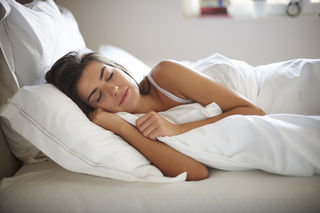Insomnia
Do Weighted Blankets Really Ease Sleeplessness?
Weighted blankets are being hyped as an insomnia cure. Do they work?
Posted August 17, 2018 Reviewed by Lybi Ma

A growing number of insomnia sufferers are looking for a better night’s sleep under a weighted blanket. These trendy blankets are filled with pellets, balls, or chains, which give them their heft. Fans of the blankets say the pressure feels like a firm hug, giving new meaning to the word “comforter.”
The idea has intuitive appeal. It could explain why some people prefer to sleep under a heavy blanket even in warm weather. Scientific research on weighted blankets is limited, however. Here’s what is known, and what isn’t, about how well the blankets work for easing insomnia in adults.
Research in Adults with Insomnia
Perhaps the best evidence to date comes from a study published in 2015 in the Journal of Sleep Medicine and Disorders. This study included 31 adults with chronic insomnia. Their sleep was tracked for one week with their usual bedding, then two weeks with a weighted blanket, and then one more week with their usual bedding again.
Four out of five study participants said they liked the weighted blanket. Those in this group slept longer and spent less time awake in the middle of the night while using the weighted blanket, sleep testing showed. Study participants also said they found it easier to settle down to sleep with the weighted blanket. Plus, they reported getting better sleep and feeling more refreshed the next morning.
The theory behind weighted blankets is that they may work, in part, by providing firm, deep pressure stimulation. “The pressure provides a reassuring and cocooning feeling,” says study coauthor Gaby Badre, M.D., Ph.D., associate professor at the University of Gothenburg and medical director of the sleep disorders clinic SDS Kliniken in Gothenburg, Sweden.
In addition, Badre says that the weighting material inside the blanket produces a lighter, stroking-like tactile sensation when you move. “This tactile stimulation, amplified by movements, even if small, maybe the equivalent of a caress,” says Badre. It may stimulate the release of neurotransmitters and affect nervous system activity in ways that decrease overarousal and anxiety.
Other Research on Weighted Blankets
Further evidence on weighted blankets comes from research in kids with various mental health concerns.
One study looked at 42 children (ages 8 to 13), half of whom had attention-deficit/hyperactivity disorder (ADHD). The children’s sleep was tracked by sleep testing and parent diaries for four weeks, including two weeks of using a weighted blanket. For kids with ADHD, the weighted blanket reduced the time it took to fall asleep and the number of middle-of-the-night awakenings to a level comparable to children without ADHD.
Research in 73 young people (ages 5 to 16) with autism spectrum disorder (ASD) and severe sleep problems compared a weighted blanket to an identical blanket without the extra weight. Based on sleep testing and parent diaries, the weighted blanket didn’t improve their sleep. Yet kids and parents preferred the weighted blanket. They may have been picking up on a benefit the researchers didn’t measure. But because they could tell which blanket was heavier, they may also have been swayed by stories on social media and in the press touting weighted blankets for kids with ASD.
For now, we’re left with more questions than answers about the benefits of weighted blankets for people with sleep issues. “There is much more research needed in this regard,” says Courtney Golding, Ph.D., a sleep psychologist at Spectrum Health Sleep Medicine in Grand Rapids, Michigan.
When Insomnia Weighs on Your Mind
Still, a blanket that hugs you all night long sounds awfully nice. And some experts say it's plausible that weighted blankets could help fend off sleeplessness. “Given that insomnia is frustrating, it can lead to anxiety related to sleep (or lack thereof) even in individuals who are not typically anxious,” says Golding.
These individuals may need a little extra soothing at bedtime—exactly the kind of soothing that a weighted blanket is designed to provide. Golding says that “steady sensory input and pressure can reduce the body’s physiological arousal level, leading to a reduction in feelings of anxiety and tension.”
Things to Consider
If you’re thinking about buying a weighted blanket for an adult, Badre says it should typically be more than 10 percent of the user's body weight. However, he notes that people vary in exactly how heavy or light they prefer the blanket to be. If possible, try before you buy to find what’s comfortable for you.
Of course, the blanket should never be so heavy that it restricts your movement or is difficult for you to manage. To be on the safe side, elderly individuals and those with health concerns should talk with their health care provider before trying a weighted blanket. This type of blanket may not be appropriate for people with breathing difficulties, circulatory problems, or temperature regulation issues.
Make sure the weight is evenly distributed throughout the whole blanket. Badre adds, “It is important that the blanket does not increase the temperature of the bedding. The fabric should dissipate heat easily.”
If you’re handy with a sewing machine, you may be able to make your own weighted blanket. “Otherwise, weighted blankets can run on the expensive side,” says Golding. Due to the dearth of research, it’s impossible to predict who will get a good return on their investment. Yet an increasing number of insomniacs seem to be deciding that the possibility of a good night’s sleep is priceless.
References
Ackerley, R., Badre, G., & Olausson, H. (2015). Positive effects of a weighted blanket on insomnia. Journal of Sleep Medicine & Disorders, 2(3), 1022.
Gringras, P., Green, D., Wright, B., Rush, C., Sparrowhawk, M., Pratt, K., . . . Wiggs, L. (2014). Weighted blankets and sleep in autistic children: A randomized controlled trial. Pediatrics, 134(2), 298-306. doi:10.1542/peds.2013-4285d
Hvolby, A., & Bilenberg, N. (2011). Use of Ball Blanket in attention-deficit/hyperactivity disorder sleeping problems. Nordic Journal of Psychiatry, 65(2), 89-94. doi:10.3109/08039488.2010.501868




